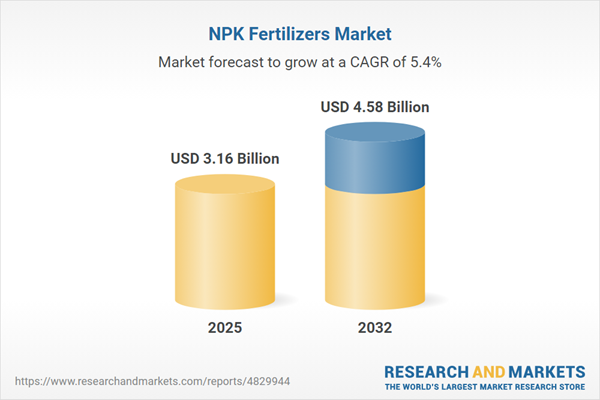Speak directly to the analyst to clarify any post sales queries you may have.
Senior leaders in the NPK fertilizer market face continuous shifts driven by technology, regulation, and sustainability imperatives. Navigating these complexities requires a proactive approach—leveraging innovation, adaptive planning, and strategic partnerships to remain competitive in a challenging global environment.
NPK Fertilizer Market Snapshot and Growth Drivers
The NPK fertilizer market is projected to reach USD 4.58 billion by 2032, advancing from USD 3 billion in 2024 with a compound annual growth rate of 5.42%. Primary factors driving this growth include intensifying concerns around global food security and the urgent need to optimize agricultural inputs. As organizations recognize supply chain resilience as core to their growth strategies, advanced nutrient management is gaining traction. Digitalization, precision application, and data-driven agronomy are being implemented across regions, with ecological responsibility and regulatory alignment shaping purchasing decisions and operational investments.
NPK Fertilizer Market Scope & Segmentation
- Form: Granular NPK fertilizers provide flexible nutrition across crop types, supporting custom blends for diverse application needs. Liquid formulations enable rapid nutrient absorption, particularly useful during condensed growth periods. Powdered products support high-value and specialty crops, aligning with precision-focused agriculture.
- Crop Types: These fertilizers address requirements for cereals, oilseeds, pulses, fruits, and vegetables, enabling tailored nutrition plans that adapt to regional soil characteristics and specific yield targets.
- Release Types: Controlled-release offerings prolong nutrient availability for sustained plant health, while rapid- and slow-release options grant flexibility for variable crop cycles and operational timing.
- Applications: Drip and sprinkler fertigation streamline input delivery and optimize use efficiency. Foliar and soil-based techniques offer adaptability, ensuring timely support during critical crop development phases and across diverse climatic zones.
- Distribution Channels: Dealer networks maintain crucial market reach at the local level, direct sales cater to urgent purchasing requirements, and online procurement increases transparency and market entry opportunities for established and new participants alike.
- Geographical Regions: The Americas, Europe, Middle East & Africa, and Asia-Pacific drive industry leadership, with the United States, China, Brazil, Germany, and India setting benchmarks through policy, infrastructure, and agricultural best practices.
- Leading Companies: Influential market players include Nutrien Limited, Yara International ASA, The Mosaic Company, EuroChem Group AG, CF Industries Holdings, OCP S.A., Israel Chemicals Ltd, PhosAgro, K+S Aktiengesellschaft, and Haifa Group Ltd. Their innovation and ethical focus set new performance standards and shape competitive dynamics.
NPK Fertilizer Market: Key Takeaways for Senior Executives
- Integrate digital technologies throughout procurement and logistics to heighten operational flexibility and respond efficiently to market and regulatory shifts.
- Emphasize rigorous compliance and robust risk management to address tightening sustainability requirements and ensure alignment with evolving regulatory frameworks.
- Expand distribution approaches by balancing dealer, direct, and online channels to reduce exposure to regional disruptions and access new markets.
- Strengthen alliances with technology and logistics providers to increase scalability and ensure seamless operations amid changing customer and market expectations.
- Refine product portfolios in response to local agronomic needs and government policies to enhance responsiveness and competitive positioning.
- Harness digital procurement solutions to identify emerging opportunities and accelerate critical supply chain processes for timely delivery and customer satisfaction.
Tariff Impact: Navigating Trade and Pricing Developments
Recent changes in U.S. import duties on NPK fertilizers present additional volatility, requiring agile supply chain adjustments and precise regulatory tracking. Organizations benefit from strategic sourcing and risk evaluation to stabilize input pricing and maintain strong market positioning despite evolving international trade frameworks.
Methodology & Data Sources
This research synthesizes insights from direct interviews with manufacturers, suppliers, agronomists, and end users in the NPK fertilizer market. Established analytic frameworks, including Porter’s Five Forces and PESTEL, underpin the findings to ensure actionable value for senior leadership.
Why This Report Matters for Decision-Makers
- Guides leadership in crafting tailored product and channel strategies that match the dynamics of target regions and specific agricultural markets.
- Delivers a comprehensive framework for enhancing risk and sustainability management amid complex and evolving compliance landscapes.
- Supplies sourcing and operations teams with intelligence to foresee and address potential supply chain and regulatory disruptions before they impact business performance.
Conclusion
Strategic leadership in the NPK fertilizer market is rooted in digital adoption and agile responses to sustainability and regulatory trends. Focusing on these priorities positions organizations for decisive growth and lasting advantage.
Additional Product Information:
- Purchase of this report includes 1 year online access with quarterly updates.
- This report can be updated on request. Please contact our Customer Experience team using the Ask a Question widget on our website.
Table of Contents
3. Executive Summary
4. Market Overview
7. Cumulative Impact of Artificial Intelligence 2025
Companies Mentioned
The companies profiled in this NPK Fertilizers market report include:- Nutrien Limited
- Yara International ASA
- The Mosaic Company
- EuroChem Group AG
- CF Industries Holdings, Inc.
- OCP S.A.
- Israel Chemicals Ltd
- PhosAgro Public Joint Stock Company
- K+S Aktiengesellschaft
- Haifa Group Ltd
Table Information
| Report Attribute | Details |
|---|---|
| No. of Pages | 191 |
| Published | October 2025 |
| Forecast Period | 2025 - 2032 |
| Estimated Market Value ( USD | $ 3.16 Billion |
| Forecasted Market Value ( USD | $ 4.58 Billion |
| Compound Annual Growth Rate | 5.4% |
| Regions Covered | Global |
| No. of Companies Mentioned | 11 |









